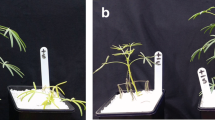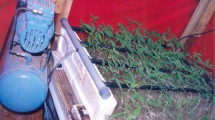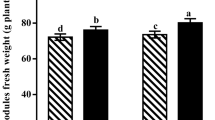Abstract
The response of narrow-leafed lupins (Lupinus angustifolius L. cv. Illyarrie) to phosphorus (P) fertilizer applied as single superphosphate (super), as an elemental-sulphur-enriched, partially acidulated rock phosphate (esparp) and as biosuper, was investigated in a glasshouse pot trial. Measurements of plant yield and P uptake were recorded 41 and 76 days after sowing. Both dry matter production and P uptake from esparp and super were proportional to the amount of water soluble P added to the pots indicating that the non-water-soluble fractions from these fertilizers were not taken up by the lupin plants. A small amount of initially insoluble P from the higher rates of biosuper was taken up by day 76. Thus superphosphate was clearly the most effective P source for this lupin species followed by esparp while biosuper was ineffective. Similar responses were recorded for pod and nodule dry weights. It was concluded that less soluble P sources were not suitable as fertilizers in lupin production due to the poor response in P uptake, dry matter accumulation and nodulation.
Similar content being viewed by others
References
Andersen AJ and Thomsen JD (1979) Efficiency in absorption and utilization of phosphorus of four plant species. In: Isotopes and Radiation in Research on Soil-plant Relationships. 499–509. IEAA, Vienna
Asher CJ and Loneragan JF (1967) Response of plants to phosphate concentration in solution culture I Growth and phosphorus content. Soil Sci 103: 225–233
Barber SA (1979) Growth requirements for nutrients in relation to demand at the root surface. In: ‘The Soil-Root Interface’ JL Harley and RS Russel (eds) pp. 5–20. London: Academic Press
Bethlenfalvay GJ and Yoder JF (1981) TheGlycine-Glomus-Rhizobium symbiosis. Physiol Plant 52: 141–145
Cribb J (1985) National Farmers Federation: Australian Agricultural Yearbook 1985. Strand: Brisbane
Dean LA and Fried M (1953) Soil plant relationships in the phosphorus nutrition of plants. In: ‘Soil and Fertilizer Phosphorus in Crop Nutrition’ WH Pierre and AG Norman (eds) pp. 43–58. New York: Academic Press
Gardner WK Parbery DG and Barber DA (1982) The acquisition of phosphorus byLupinus albus L. In: Some characteristics of the soil/root interface Plant Soil 68: 19–32
Gardner WK Barber DA and Parbery DG (1983) The acquisition of phosphorus byLupinus albus L. III The probable mechanism by which phosphorus movement in the soil root interface is enhanced. Plant Soil 70: 107–124
Gladstones JS Leach BJ Drover DP and Asher CJ (1964) Field studies on the potassium and phosphorus nutrition of lupins. Aust J Exp Agric Anim Husb 4: 158–164
Higgins DJ (1981) Some technological aspects of phosphate rock as direct application fertilizers. Proceeding of the technical workshop on the potential of phosphate rock as a direct application fertilizer in New Zealand. Palmerston North, May 1981, p. 51–73
Havlin JL and Soltanpour PN (1980) A nitric acid tissue digest method for use with inductively coupled plasma spectrometry. Commun Soil Sci Pl Anal 11: 969–980
Khasawneh FE and Doll EC (1978) The use of phosphate rock for direct application to soils. Adv Agron 30: 159–206
McLean EO Wheeler RW and Watson JD (1965) Partially acidulated rock phosphate as a source of phosphorus to plants II Growth chamber and field corn studies. Soil Sci Soc Am Proc 29: 625–628
McLean EO and Logan TJ (1970) Sources of phosphorus for plants grown in soils with differing phosphorus fixation tendencies. Soil Sci Soc Am Proc 34: 907–911
Nyatsanga T and Pierre WH (1973) Effect of nitrogen fixation by legumes on soil acidity. Agron J 63: 936–940
Panda N and Misra UK (1970) Use of partially acidulated rock phosphate as a possible means of minimizing phosphate fixation in acid soils. Plant Soil 33: 225–234
Palmer B and Jessop RS (1982) The relative value of water-soluble and ammonium-citrate-soluble phosphorus for wheat production. J Agric Sci Camb 98: 467–470
Porter NG (1982) Interaction between lateral branch growth and pod set of lupin. Aust J Agric Res 33: 957–965
Purnell HM (1960) Studies of the family Proteaceae. Aust J Bot 8: 38–50
Rahman MS and Gladstones JS (1974) Differences amongLupinus species in field response to superphosphate. Aust J Exp Agric An Husb 14: 214–223
Sale PW and Blair GJ (1985) Comparative effectiveness of Esparp and superphosphate as fertilizers for perennial pastures. Proc 2nd Aust Agron Conf, Hobart Jan/Feb 1985 p. 228
Sutton PJ Peterson GA and Sander DH (1983) Dry matter production in tops and roots of winter wheat as affected by phosphorus availability during various growth stages. Agron J 75. 658–663
Swaby RJ and Sperber J (1958) Phosphate dissolving micro-organisms in the rhizosphere of legumes. In: ‘Nutrition of the Legumes’ EG Hallsworth (ed) pp 289–294. London: Butterworths
Terman GL and Allen SE (1967) Response of corn to phosphorus in underacidulated phosphate rock and rock-superphosphate fertilizers. J Agric Food Chem 15: 354–358
Trunich MJ (1977) Vesicular-arbuscular infection and soil phosphorus utilization inLupinus spp. New Phytol 78: 297–304
White WC (1974) Fertilizer sampling and analytical methods. The Fertilizer Institute Product Committee, Washington
Author information
Authors and Affiliations
Rights and permissions
About this article
Cite this article
Tremain, P., Sale, P.W.G. & Jessop, R.S. Effect of solubility of applied phosphate on the growth of narrow-leafed Lupin (Lupinus angustifolius L.). Fertilizer Research 13, 117–125 (1987). https://doi.org/10.1007/BF01064825
Accepted:
Issue Date:
DOI: https://doi.org/10.1007/BF01064825




